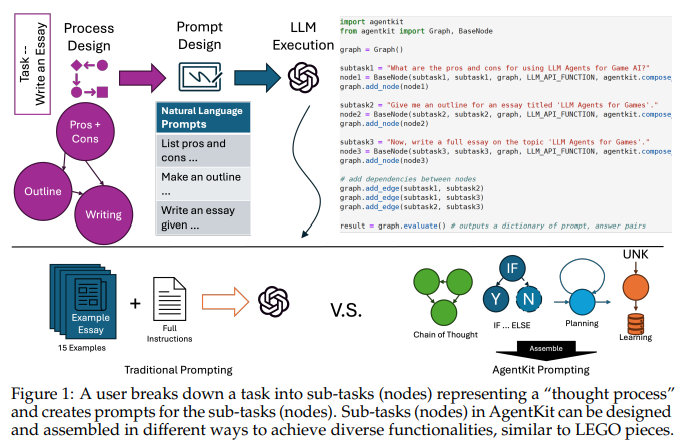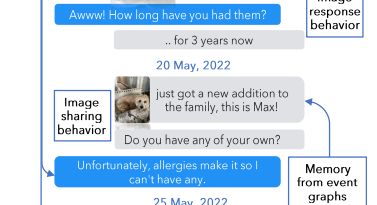AgentKit: Empowering AI Agents with Natural Language
Artificial Intelligence (AI) has made significant strides in recent years, enabling machines to perform tasks that were once exclusive to humans. One crucial aspect of AI is the development of intelligent agents that can understand complex instructions and interact seamlessly with their environment. Traditionally, building these agents required extensive coding knowledge and expertise in specific APIs, limiting their accessibility and applicability outside specialized domains. However, a groundbreaking research paper from Carnegie Mellon University (CMU) introduces AgentKit, a machine learning framework that revolutionizes the process of building AI agents using natural language prompts.
The Challenge of Agent Development
Building AI agents capable of autonomously performing tasks in digital environments is a challenging endeavor. These agents need to understand and interpret complex instructions, plan their actions, and adapt dynamically to changes in their environment. However, existing approaches heavily rely on code-intensive methods, making agent development a complex process that requires specialized skills. This not only restricts accessibility but also hampers innovation, limiting the potential applications of AI agents.
A Paradigm Shift: Natural Language in Agent Development
The research paper, co-authored by researchers from CMU, NVIDIA, Microsoft, and Boston University, introduces AgentKit as a groundbreaking framework for building AI agents using natural language prompts. Unlike traditional approaches that rely on complex coding techniques, AgentKit allows users to construct AI agents intuitively by leveraging natural language. By utilizing a graph-based design, each sub-task is represented as a node connected to others, forming a directed acyclic graph (DAG).
The core innovation of AgentKit is the use of Large Language Models (LLMs), particularly GPT-4, to interpret and generate responses to natural language prompts. These language models, trained on vast amounts of text data, excel at understanding and generating human-like language. By integrating GPT-4 into AgentKit, users can create dynamic and adaptable AI agents without the need for extensive coding knowledge.
A Graph-Based Approach to Intelligent Agents
AgentKit’s graph-based design offers several benefits in building AI agents. Each node in the graph represents a specific sub-task defined by language prompts. These nodes are interconnected based on task dependencies, ensuring a logical progression and systematic execution of tasks. The flexibility of the graph structure allows users to intuitively piece together complex agent behaviors while enhancing system accessibility and flexibility.

During execution, AgentKit dynamically adjusts these nodes in response to environmental changes or task demands. This real-time adaptation enables AI agents to efficiently respond to new scenarios and ensures continuous workflow. The output of each node serves as input to subsequent nodes, creating a seamless and efficient execution flow.
Advantages and Applications of AgentKit
AgentKit’s natural language approach to agent development offers several advantages over traditional coding-intensive methods. By empowering users to construct AI agents using intuitive language prompts, it significantly lowers the barrier to entry for agent development. This accessibility promotes innovation and opens up AI agent development to a broader range of individuals and industries.
Applications of AgentKit span across various domains, showcasing its versatility and effectiveness. In the context of gaming, the framework has demonstrated an impressive 80% improvement in task completion efficiency compared to existing methods.The ability to dynamically adjust agent behavior based on natural language prompts enhances the adaptability and responsiveness of AI agents in real-time decision-making environments.
In the e-commerce domain, AgentKit has achieved a 5% higher performance compared to state-of-the-art models for tasks such as managing online shops. These results affirm the framework’s effectiveness in handling complex tasks and highlight its practical applicability across diverse application domains.
The Future of AI Agent Development
The introduction of AgentKit represents a significant leap forward in AI agent development. By enabling the construction of complex agents through natural language prompts, the framework revolutionizes the way AI agents are built. The integration of graph-based design and LLMs like GPT-4 empowers users to intuitively create and modify AI behaviors, fostering a new era of accessible and adaptable AI technologies.

The potential impact of AgentKit reaches far beyond research labs. Its user-friendly approach to AI agent development unlocks new possibilities for industries across the board. From gaming to e-commerce, the framework’s versatility and effectiveness are poised to drive measurable improvements in agent-based task execution.
As researchers continue to push the boundaries of AI agent development, frameworks like AgentKit will play a crucial role in realizing the full potential of AI technology. By simplifying and democratizing the creation of intelligent agents, we move closer to a future where AI seamlessly integrates into our lives, enhancing efficiency and transforming industries.
Check out the Paper. All credit for this research goes to the researchers of this project. Also, don’t forget to follow us on LinkedIn. Do join our active AI community on Discord.
If you like our work, you will love our Newsletter 📰




